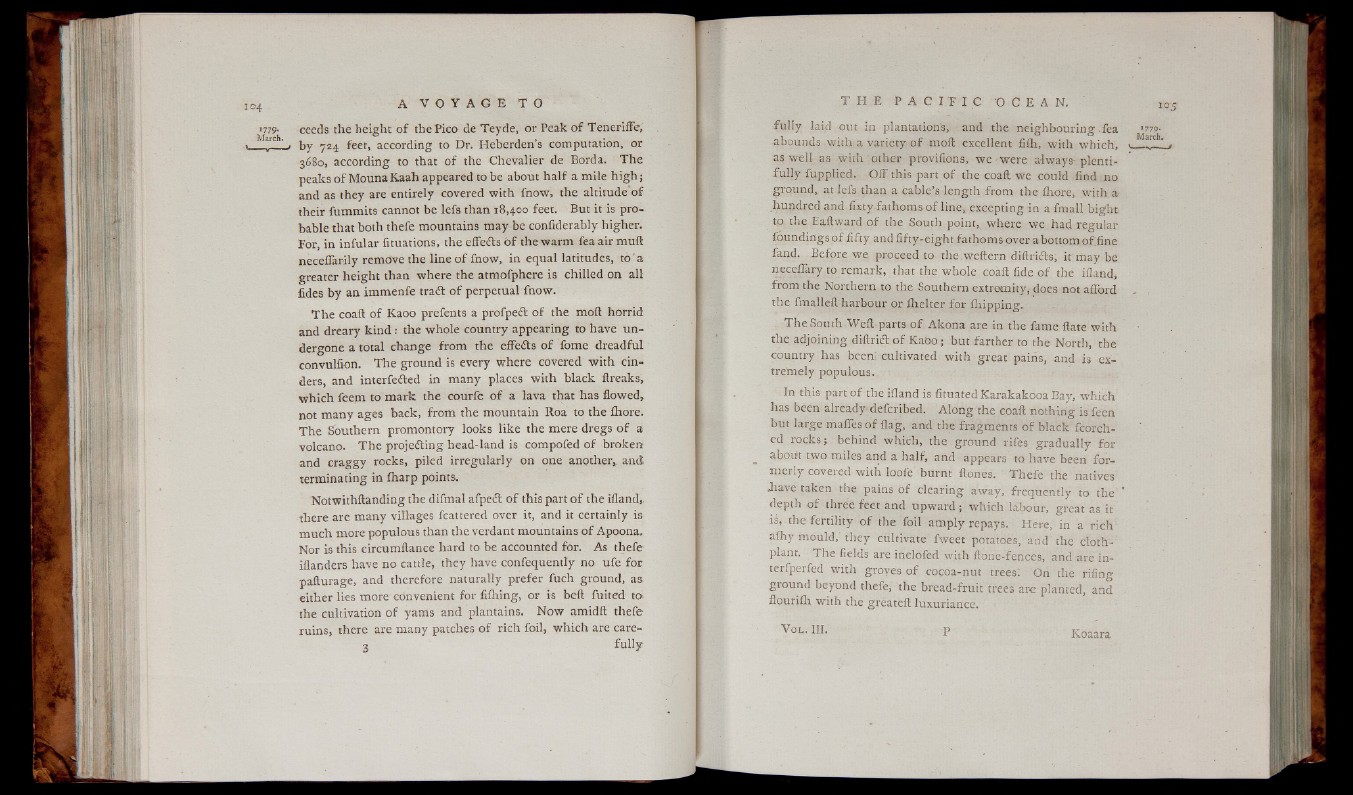
>779- ceeds the height o f the Pico de Teyde, or Peak o f Teneriffe,
. 1 ‘ . by 724 feet, according to Dr. Heberden’s computation, or
3680, according to that o f the Chevalier de Borda. T h e
peaks o f Mouna Kaah appeared to be about h a lf a mile h ig h ;
and as they are entirely covered with fnow, the altitude o f
their fummits cannot be lefs than 18,400 feet. But it is probable
that both thefe mountains may be confiderably higher.
For, in in fu lar fituations, the effedts o f the w arm fea a ir m u ll
neceffarily remove the line o f fnow, in equal latitudes, to ' a
greater he ight than where the atmofphere is chilled on all
fides b y an immenfe t r a d o f perpetual fnow.
T h e coaft o f Kaoo prefents a profpeft o f the moil horrid
and dreary kin d : the whole country appearing to have u n dergone
a total change from the effe&s o f fome dreadful
convulfion. T he ground is every where covered w ith cinders,
and in te r fe red in many places w ith b la ck ftreaks,
w h ich feem to m a rk the courie o f a la va that has flowed,
not many ages back, from the mountain Roa to the ihore.
T h e Southern promontory looks lik e the mere dregs o f a
volcano. T h e projecting head-land is compofed o f broken
and c ra g g y rocks, piled irregu la rly on one another, and
terminating in iharp points.
Notwithftanding the difmal afpedt o f this part o f the ifland,.
there are many village s fcattered over it, and it certainly is
m u ch more populous than the verdant mountains o f Apoona.
Nor is this eircumftance hard to be accounted for. As thefe
iflanders have no cattle, they have confequently no ufe for
paflurage, and therefore naturally prefer fuch ground, a s
e ither lies more convenient for fiihing, or is beft fuited to
the cultivation o f yams and plantains. N ow amidft thefe
ruins, there are many patches o f rich foil, w h ich are care-
3 £ully
fu lly laid out ip plantation's, and the n eigh bou rin g .fea wpabounds
w ith a variety o f moil excellent fifh, with w h ich , ■ Mareh'
as well as with other provifions, w e were a-lways-plentifu
lly fupplied. O ff this part o f the coaft w e could find no
ground, at lefs than a cable ’s len gth from the Ihore, with a
hundred and fixty fathoms o f line, excepting in a fmall bight
to the Eaftward o f the South point, where we had regular
foundings o f f ifty a n d fifty -e ight fathoms over a bottom o ffin e
fand. Before we proceed to the weftern diftridts, it may be
neceffary to remark, that the whole coaft fide o f the ifland,
from the Northern to the Southern extremity, does not afford
the fmalleft harbour or fhe lte r for Clipping.
T h e S o u th .Weft parts o f A kona are in the fame ftate with
the adjoining diftridl o f K a o o ; but farther to the North, the
country has been; cultivated w ith grea t pains, and is extremely
populous.
In this part o f the ifland is fituated K arakakooa Bay, w h ich
has been already- defcribed. A lo n g the coaft nothing is feen
but large maffes o f flag, and the fragments o f b la ck fcorch-
ed ro ck s ; behind w hich, the ground rifes g rad u a lly fo r
about two miles and a ha lf, and appears to have been fo rm
e rly covered with loofe burnt flones. T h e fe the natives
.have taken the pains o f clearing awa y , freq u en tly to the '
depth o f three feet and upward ; which, labour, great as it
is, the fertility o f the foil amply repays. H e re / in a rich
alhy mould, they cultivate fweet potatoes, and the cloth-
plant. The fields are inclofed with ftone-fences, and a re in-
terfperfed with groves o f cocoa-nut trees: On the riling
ground beyond thefe, the bread-fruit trees are planted, and
flourifh with the greateft luxuriance.